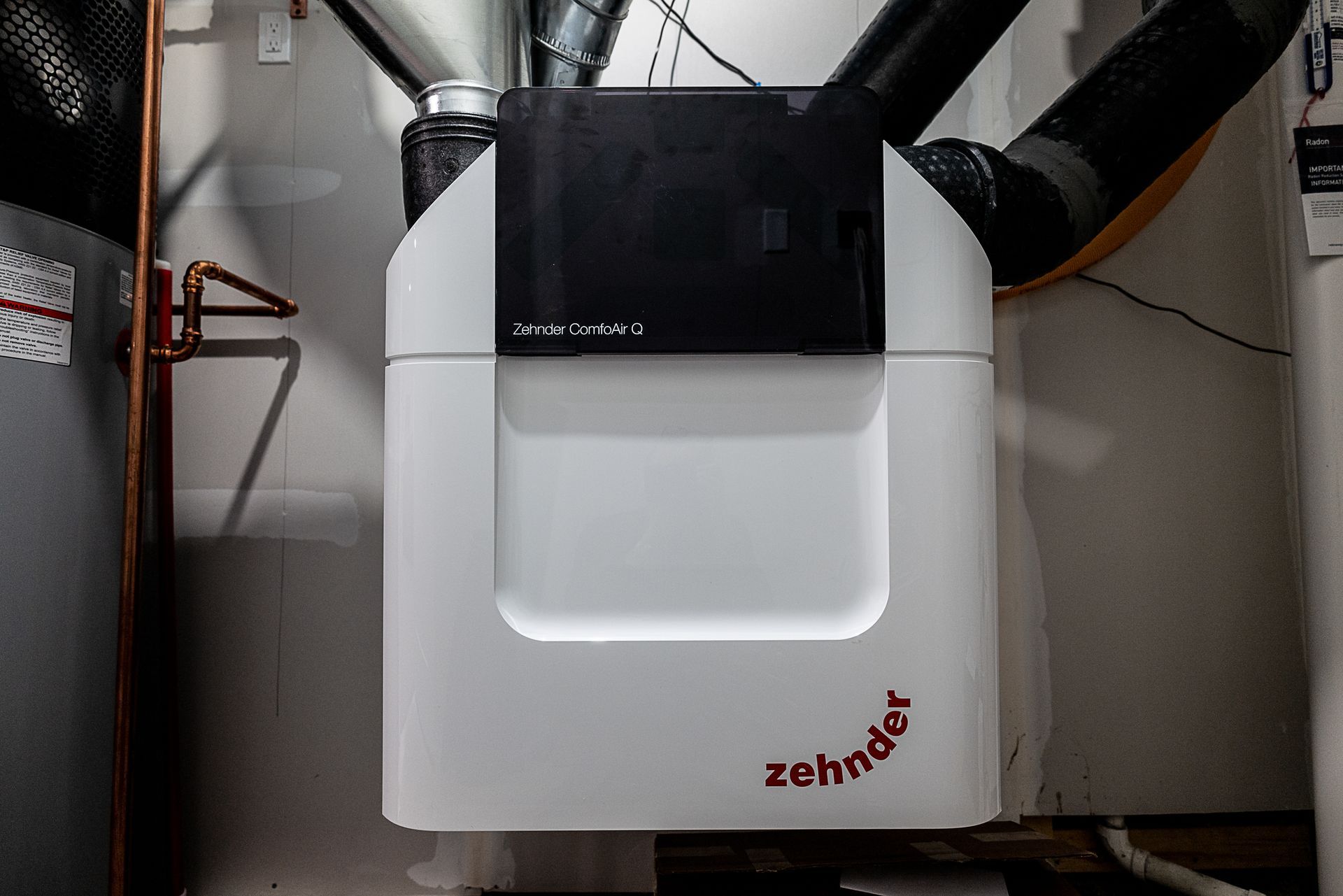The Energy Recovery Ventilator (ERV) Explained
Excellent indoor air quality, energy efficiency, occupant comfort, and durability are all improved if your home is air sealed from the outdoors and filtered fresh air with energy and humidity recovery is delivered to the inside, keeping your home, and the humans in it, healthy. And that’s where our old buddy ERV comes in.
What is an Energy Recovery Ventilator (ERV)?
The ERV is a machine that continuously exchanges indoor and outdoor air, while recycling both energy and moisture between the two streams. A properly configured ERV system will exchange all of the air in your home with fresh outside air quietly and consistently approximately every three hours 24/7 365 days per year.
Why is an ERV important?
An ERV is a required piece of kit in a home as carefully constructed as a Kala home. It keeps indoor air healthy, typically better than EPA IAQ Version 2, by continually supplying fresh, filtered air while simultaneously minimizing energy loss and helping stabilize indoor humidity.
How does an ERV work?
An ERV uses a heat exchanger core (often a paper or polymer membrane) where two air streams pass by each other but don’t mix. In winter the ERV captures heat and some moisture by exhausting warm air and transfers it into the cold, dry incoming air so that fresh air enters warmer and not overly dry. In summer it captures coolness and some moisture from the outgoing conditioned air and transfers it to the hot, humid incoming air so that fresh air enters cooler and less humid.
What are the benefits of an ERV?
- Building durability is improved through balanced ventilation which reduces pressure imbalances that can cause moisture problems in walls.
- Occupant health is improved because the ERV constantly supplies fresh, filtered air, reducing allergens, indoor pollutants, and CO₂ buildup.
- Occupant comfort is enhanced by modulating both the temperature and humidity of incoming air to match more closely with the inside air.
- Energy efficiency is greatly improved by reducing the heating and cooling load compared to standard ventilation.
If I have an ERV can I open my windows?
Absolutely. You are free to open as many windows for as long as you would like when you feel it is desired or appropriate. We all appreciate listening to a gentle summer rain, or the birds chirping first thing in the morning on a cool day, or just the sounds of the neighborhood. The energy level of Kala home is so stable because of its thermal design that the ERV will quickly rebalance any change in air quality from a quick flood of outside air.
What does an ERV look like?

ERVs come in a variety of shapes and configurations. But they are always a separate piece of kit in your mechanical room that has four primary trunk lines for supply and exhaust to and from the outside, supply and exhaust to and from the inside, and the box where the energy exchange magic happens the typically work through a separate small, flexible duct system running through your house.
Why is a fully-ducted ERV system important?
Although there are different approaches to installing an ERV, Kala installs fully ducted ERV solutions in all but the most limited instances. There are a number of reasons why we do this.
- Provides balanced, consistent fresh air delivery to all living spaces while exhaust is gathered from targeted high-moisture and odor areas. This avoids stale spots and ensures even air quality throughout the home.
- Maximizes the ERV’s efficiency by ensuring that the system exchanges stale and fresh air directly where needed. This reduces energy loss and allows better control of humidity and temperature transfer.
- Is effectively silent since the ERV ducts are separate and use silencers. Residents don’t hear air rushing in or out of a single grille.
- Allows zoning and better balancing of airflow and works independently of heating/cooling cycles, so fresh, filtered air is constant.
What are the downsides to a central, or un-ducted ERV system?
The alternative to a ducted ERV system is one that isn’t. That simply means it utilizes your homes existing ductwork to as the delivery and exhaust path. This approach is not as effective has a separately ducted system and here are some reasons why.
- Generally limits fresh air supply and exhaust capture to a single location leading to uneven ventilation and less predictable indoor air quality.
- Dilutes effectiveness and increases heating and cooling load by mixing fresh air with conditioned air before distribution.
- Less targeted humidity and moisture control from showers or cooking.
- Is generally more noisy at the main supply and exhaust point and less comfortable since fresh air may feel drafty.
- Ventilation will generally not occur unless the main HVAC air handler is running, lowering efficiency.
What is the difference between an ERV and a Heat Recovery Ventilator (HRV)?
An HRV only transfers heat during the exchange process. An ERV transfers both heat and moisture in the form of humidity. An HRV is appropriate in predominantly cold or dry conditions. An ERV is the appropriate tool for the Kansas City region that is classified as a warm/humid environment.
Is an ERV difficult to maintain?
No. An ERV is easily maintained by simply replacing filters often enough to ensure they are clean. This is typically every six months but can vary based on the environment your home is in. The ERV is also a very well understood system and can easily be maintained over time by almost any qualified HVAC service technician.




